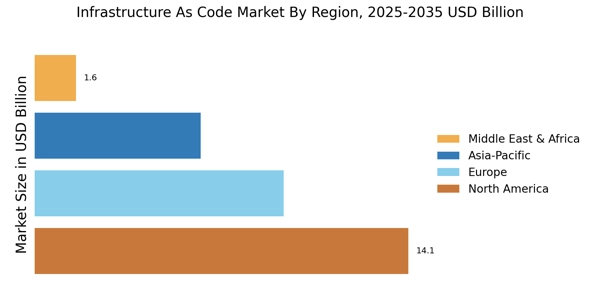Rising Demand for DevOps Practices
The Infrastructure As Code Market is experiencing a notable surge in demand for DevOps practices. Organizations are increasingly adopting DevOps methodologies to enhance collaboration between development and operations teams. This shift is driven by the need for faster software delivery and improved operational efficiency. According to recent data, the adoption of DevOps tools has grown by approximately 20% annually, indicating a robust trend towards automation and streamlined processes. As companies seek to implement continuous integration and continuous deployment (CI/CD) pipelines, the Infrastructure As Code Market plays a crucial role in facilitating these practices, allowing for rapid infrastructure provisioning and management. This growing emphasis on DevOps is likely to propel the Infrastructure As Code Market forward, as businesses recognize the value of integrating development and operations to achieve their strategic objectives.
Emergence of Multi-Cloud Strategies
The Infrastructure As Code Market is witnessing the emergence of multi-cloud strategies among organizations. As businesses seek to leverage the strengths of various cloud providers, the complexity of managing multiple environments increases. Infrastructure as Code offers a solution by enabling consistent management and deployment across diverse cloud platforms. Recent studies indicate that approximately 70% of enterprises are adopting multi-cloud strategies, driven by the desire for flexibility, cost optimization, and risk mitigation. This trend necessitates robust IaC tools that can facilitate seamless integration and orchestration across different cloud environments. Consequently, the Infrastructure As Code Market is likely to experience growth as organizations invest in IaC solutions to effectively manage their multi-cloud infrastructures and ensure operational efficiency.
Expansion of Cloud Computing Services
The Infrastructure As Code Market is significantly influenced by the expansion of cloud computing services. As organizations migrate their operations to the cloud, the need for efficient infrastructure management becomes paramount. The cloud computing market has been projected to reach a valuation of over 800 billion dollars by 2025, which underscores the increasing reliance on cloud-based solutions. Infrastructure as Code (IaC) enables organizations to automate the provisioning and management of cloud resources, thereby enhancing scalability and flexibility. This trend is particularly evident as businesses seek to optimize their cloud environments, reduce costs, and improve resource utilization. The Infrastructure As Code Market is poised to benefit from this expansion, as more companies adopt IaC practices to streamline their cloud operations and ensure seamless integration with various cloud platforms.
Increased Investment in IT Infrastructure
The Infrastructure As Code Market is benefiting from increased investment in IT infrastructure. Organizations are recognizing the importance of modernizing their IT environments to remain competitive in a rapidly evolving digital landscape. Recent reports indicate that global IT spending is projected to exceed 4 trillion dollars by 2025, with a significant portion allocated to infrastructure upgrades. This investment is driving the adoption of Infrastructure as Code practices, as businesses seek to automate and optimize their infrastructure management processes. By implementing IaC, organizations can achieve greater agility, reduce operational costs, and enhance their ability to respond to market changes. This trend suggests that the Infrastructure As Code Market will continue to thrive as companies prioritize investments in their IT infrastructure to support their strategic goals.
Growing Focus on Compliance and Governance
In the Infrastructure As Code Market, there is a growing focus on compliance and governance. As regulatory requirements become more stringent, organizations are compelled to adopt practices that ensure adherence to industry standards. Infrastructure as Code provides a framework for automating compliance checks and maintaining consistent configurations across environments. This capability is particularly vital in sectors such as finance and healthcare, where regulatory compliance is critical. The market for compliance automation tools is expected to grow significantly, with estimates suggesting a compound annual growth rate of around 15%. By leveraging IaC, organizations can not only streamline their compliance processes but also enhance their overall governance frameworks. This trend indicates that the Infrastructure As Code Market will continue to evolve in response to the increasing demands for regulatory compliance and risk management.


















Leave a Comment